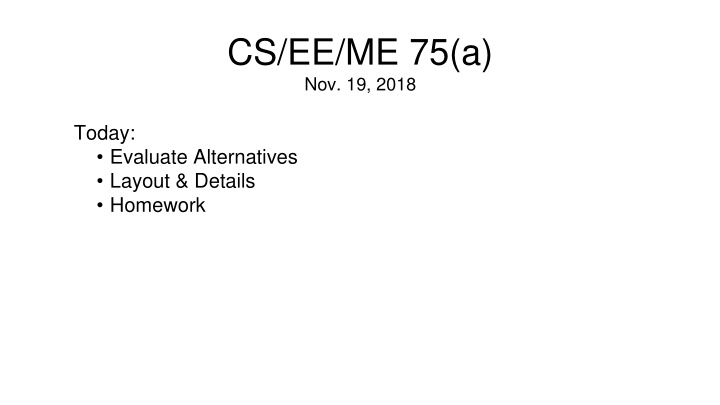
Structured Design Methods and Evaluation for Alternatives in CS/EE/ME
Explore the structured design methods and evaluation techniques for generating and selecting alternatives in the realm of Computer Science, Electrical Engineering, and Mechanical Engineering. Discover methodologies such as morphology charts, idea scoring, Pugh analysis, and bubble diagrams to streamline the design process efficiently.
Download Presentation

Please find below an Image/Link to download the presentation.
The content on the website is provided AS IS for your information and personal use only. It may not be sold, licensed, or shared on other websites without obtaining consent from the author. If you encounter any issues during the download, it is possible that the publisher has removed the file from their server.
You are allowed to download the files provided on this website for personal or commercial use, subject to the condition that they are used lawfully. All files are the property of their respective owners.
The content on the website is provided AS IS for your information and personal use only. It may not be sold, licensed, or shared on other websites without obtaining consent from the author.
E N D
Presentation Transcript
CS/EE/ME 75(a) Nov. 19, 2018 Today: Evaluate Alternatives Layout & Details Homework
Structured Design Method(s) Recognition of a Need Clarification of Objectives Establish Function Set Requirements Problem Definition Generate Alternatives Evaluate Alternatives Create Details Solution Generation Preliminary Design Review! Analysis & Optimization Prototyping
Structured Design Method(s) Recognition of a Need Generate Alternatives Morphology chart Evaluate Alternatives Idea Scoring/Ranking Create Details/Layout Problem Definition Solution Generation Analysis & Optimization Prototyping
Generate Solutions Goal: Create as many distinct solutions as possible. Create many possible alternative rearrangement of components Organize alternatives for future evaluations Classify alternatives Morphology Chart (best for electromechanical design problems): Required functions/features along rows Different design alternatives and combinations along rows. Phrases or sketches to capture the concept Sometimes other alternatives, such as concept diagrams or classification trees, are better suited to a given problem
Homework Develop a scoring system for your morphologies & Design Alternatives Rank your alternatives. Select, as appropriate, ideas for continuation Rough Layout of your solution.
